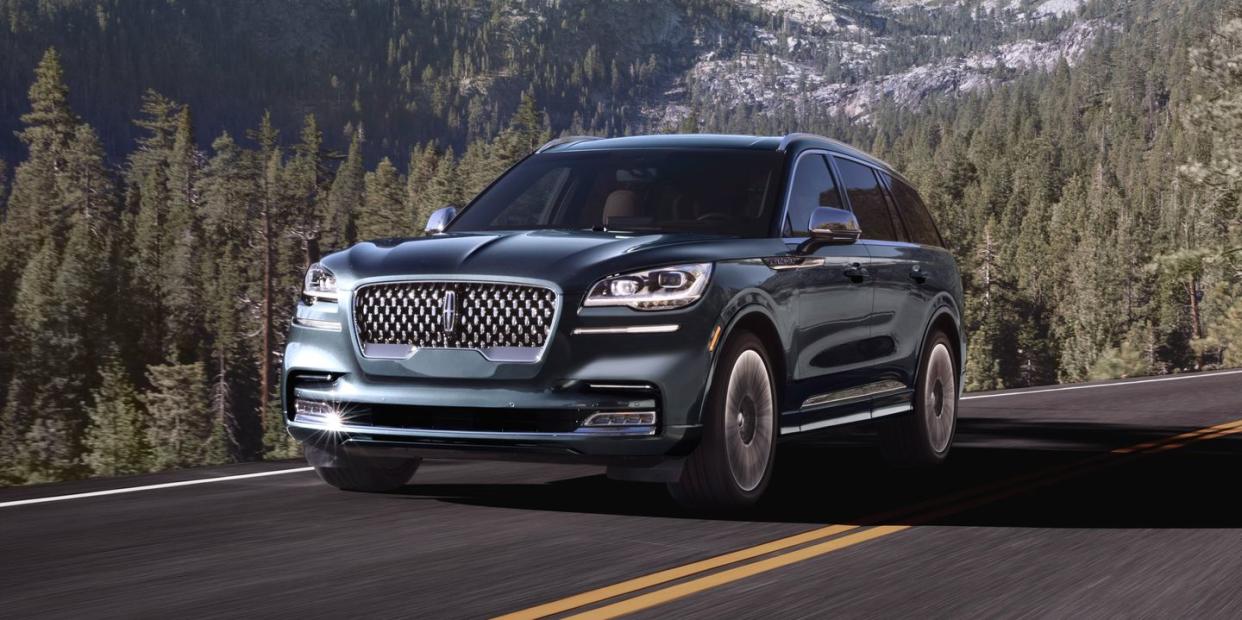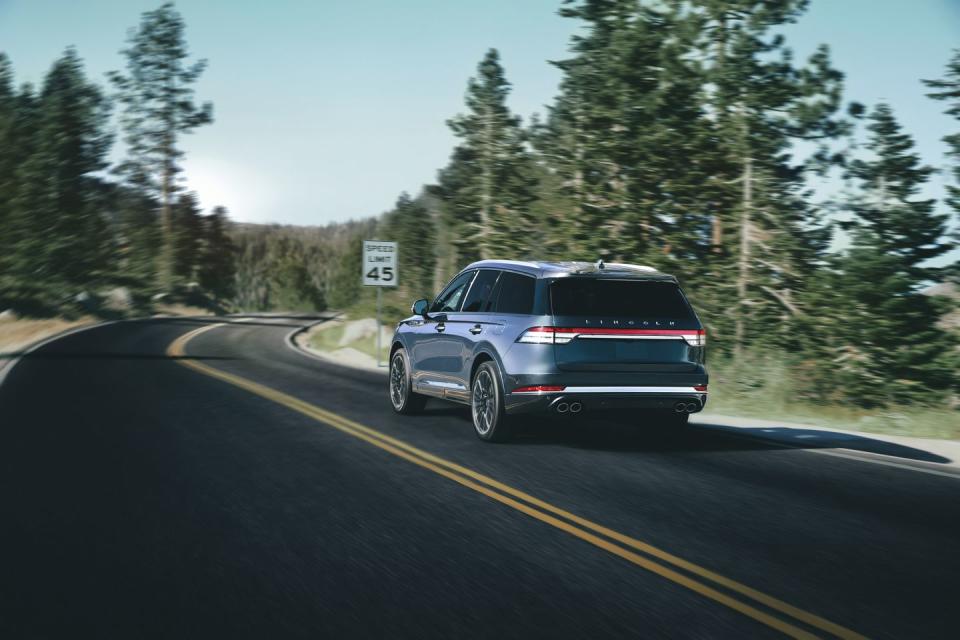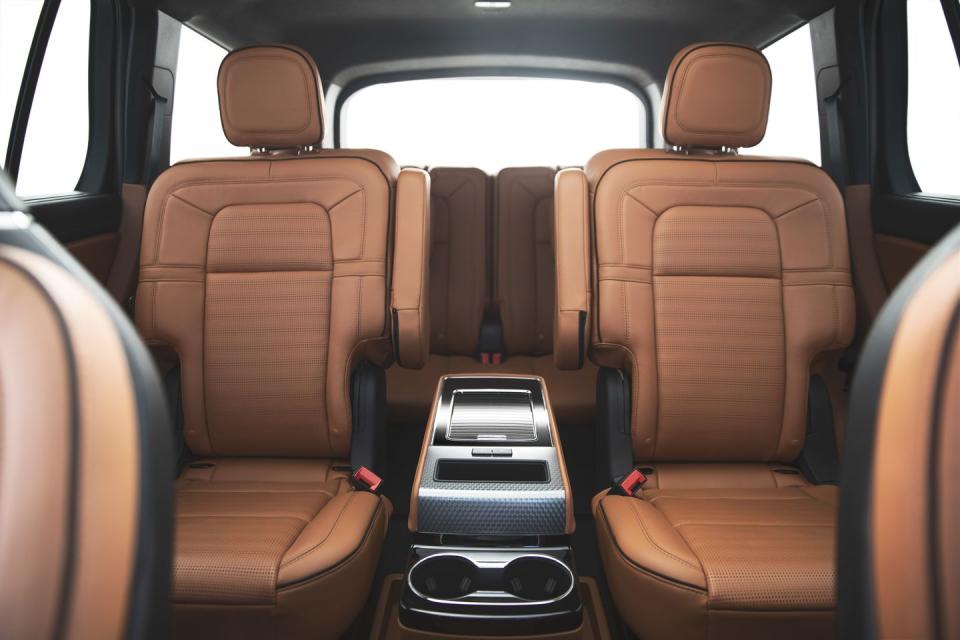2020 Lincoln Aviator Channels Luxury Over Performance

10/2/19 UPDATE: This review has been updated with test results for the Aviator V-6 Black Label.
We are sad to report that the 2020 Lincoln Aviator is not the flying car we’ve been promised for the better part of a century. The Aviator is stuck to the earth just like you and me. Metaphorically, though, this two-and-a-half-ton leather-and-wood-trimmed box has the wings to help lift Lincoln out of what a few short years ago looked like an unrecoverable nosedive.
There’s an American bulk to the Aviator’s proportions and enough width in the cabin that at least a few buyers will believe they’re driving the larger Navigator. The 400-hp twin-turbo V-6 is eager to run hard. Just as important, the Aviator has the looks of a proper luxury vehicle.
Same Formula, New Execution
That last factor marks a big change over the Aviator's front-drive-based predecessor, the homely and hunched MKT. The Aviator buries the MKT's ancient bones and moves to a new architecture that rotates the engine 90 degrees so that torque now flows to either the rear wheels or all four. Sharing this core componentry with the new Explorer,the Aviator is still very much a gilded Ford. Crucially, the visible and tangible similarities are few and insignificant enough not to matter.

The standard twin-turbo 3.0-liter V-6 is a powerful part of the Aviator's appeal. Making 400 horsepower and 415 lb-ft of torque, the base engine outguns the competition's—in many cases by more than 50 horses. The engine operates silently enough to be forgotten at cruising speeds. With a poke of the accelerator, the V-6 roars to attention and rockets the Aviator down the road. Ford's 10-speed automatic transmission continues to improve with every new application, including this one. In the Aviator, the transmission picks gears assertively yet executes shifts with a gentle smoothness.
The twin-turbo mill feels stronger than it performs, though. At our Michigan test track, a 5195-pound all-wheel-drive Black Label model accelerated to 60 mph in a modest 6.0 seconds. The BMW X5 xDrive40i pulls off the same feat in just 4.9 seconds and the Mercedes-Benz GLE450 4Matic makes the run in 5.3 seconds. But the Lincoln’s time is good enough to outrun the Audi Q7 and the Cadillac XT6.[TE1]
Over 500 miles of routine driving, the V-6 Aviator averaged 17 mpg, missing its combined EPA rating by 3 mpg. The results were more impressive in our highway fuel-economy loop. Driving a constant 75 mph, the Aviator returned 24 mpg, the same as the EPA’s highway rating.
In place of an optional V-8, Lincoln offers the blown V-6 paired with an electric motor and a 13.6-kWh lithium-ion battery. The $69,895 plug-in-hybrid model, known as the Aviator Grand Touring, makes 494 horsepower and 630 lb-ft but adds another nearly 800 pounds to the already heavy Aviator. Cleverly, Lincoln hides the hefty battery pack beneath the body, leaving the underfloor cargo space and spare-tire well intact.
Lincoln says the Grand Touring should be good for about 18 miles of electric-driving range, but you're unlikely to experience that all in one shot. Relying solely on the 100-hp electric motor in Pure EV mode moves the Grand Touring's 5700 pounds at a snail's pace that luxury buyers won't tolerate. Instead, they'll drive the Grand Touring in one of the many modes that blend the two powertrains with the gas engine switching on and off frequently. While you'll hardly notice the V-6 refire, the Grand Touring's sense of refinement is ruined by a small but noticeable thunk every time the driveline reengages the gas engine.
A California-Compliant Suspension
While the $52,195 base Aviator rides on steel coil springs and passive dampers, most buyers will end up with a more sophisticated suspension. Starting at $59,795, the mid-level Reserve trim with all-wheel drive comes standard with adaptive dampers. The Dynamic Handling package pairs those electronically controlled dampers with a camera that looks 50 feet down the road to relax or tighten the dampers based on the topography of the pavement. That option also adds variable-ratio steering and air springs with more than three inches of travel between the egress and off-road positions.

The Aviator carried its mass gracefully through rolling Napa vineyards on our drive with the pothole-spotting, height-adjusting suspension. It stays nicely upright in corners and follows the driver's intentions faithfully. As with its acceleration, the Aviator’s chassis is more competent when it is experienced, rather than measured. The gas-engine Aviator managed 0.82 g of lateral grip during our track testing, a tepid but unsurprising performance given its heft and height. A 174-foot stop from 70 mph places the Aviator’s braking capability right in line with that of its peers. On the road, the Aviator’s body bounced and bobbled a bit more than we prefer in spots where the pavement resembled sourdough crust. Generally, though, it rides comfortably with the right amount of isolation and connection.
Tech without the Learning Curve
The Aviator's equipment list is stuffed with driver-assistance and connectivity features just as you'd find in any other modern luxury vehicle. What sets the Lincoln apart is that the tech is unpretentious and easy to use. The piano-key gear selector, a no-gimmicks touchscreen, physical climate controls, and the ability to use your phone as a key create a luxury experience with no learning curve. Hedonic indulgences include Lincoln's 30-way Perfect Position seats, a 28-speaker Revel Ultima sound system, and the megabucks Black Label cabin treatment. Unless you spring for that last one, several of the Aviator's interior materials look and feel like nonluxury fare.

Behind the second row, Lincoln favors cargo room over passenger space. The thinly padded third row sits low to the floor and offers scant legroom. Sitting back there is barely more comfortable than squatting on a sack of rice, and squeezing between the C-pillar and the second-row captain's chair (standard on all but the base model) is a challenge. But there's plenty of room behind the third row for four kids' backpacks, sports bags, and then some.
For anyone in the first or second rows, the Aviator delivers a genuine luxury experience. It's quiet when you want peace and quick enough when you need speed. When properly equipped, the Aviator will massage your backside while subtly persuading your neighbors that business is good. And while we wish it could fly, this Lincoln isn't going to apologize for its size. The Aviator is a proper luxury vehicle built in the American style.
You Might Also Like

